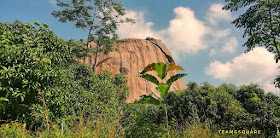I was all set to descend
the hill of Anjaneri after resting
for a while at the Anjani Mata temple.
The experience uphill was exhilarating and I was fully charged up. However
during my descent a group of temples situated a little distance away from the
village of Anjaneri caught my attention. Hence, I decided to explore these
temples of Anjaneri on reaching the base, completely forgetting about the caves
that I wished to explore around the lakes. There are a few cave temples and an ashram
besides a lake on the rear side of the first temple. As I continued my descent
and reached the trek base, I immediately ordered a plate of special Maggi
noodles at a hotel owned by an elderly person. I was extremely hungry and gulped
down 2 full plates of noodles. My legs were tired and I started to have second
thoughts about exploring the temple complexes near the village by foot. The
temple complex was located at a distance of at least 2 km from the trek base.
In the meanwhile, a bunch of boys who returned to their vehicle after
completing the trek offered to drop me off till the cross-road and I happily
welcomed their offer.
 |
| Hot Maggi |
After thanking them, I walked across the village of Anjaneri
where I could sight the ruins of many temples spread here and there. I reached
a spot where I found 3
Hero stones /
Sati stones. Here on, I visited the first temple complex which was in ruins.
It housed a big temple of Lord Vishnu along with another smaller temple dedicated
to Goddess Lakshmi.
The temples remain
mostly damaged, with some restoration work being undertaken currently by the ASI.
The grandeur of this temple can be felt even in its ruins. It is disheartening
to witness the state of this temple today. The main temple is built as per the ‘
saptharatha
plan’ and houses a damaged yet beautiful
‘panchabhuma bhumija shikhara’,
which can be classified under the ‘
Hemadpanti/Hemadpanthi
Style of Architecture’.
Hemadpant
was a celebrated physician of the Dwaparayuga, who cured Vibhishana, the
brother of Ravana, King of Lanka.
In
return, he begged the services of some giant architects with whose help he
built numerous temples and step wells in western India, and these styles were collectively
classified as ‘Hemadpanti Style of Architecture’. Historically,
Hemadri or Hemadpant was a minister of
the 9
th Devagiri Yadava King Ramachandra (1271 -1308 CE), who was
also a great writer and went on to build numerous temples in this region in Hemadpanthi
Style of Architecture. There are carvings of Lord Vishnu’s incarnations on the
outer walls of this temple. The door frame of the garbhagriha is of
Chausakha with beautiful carvings
of Trimurti (Lords Brahma, Vishnu and Maheshwara) along with Lord Ganesha and
Goddess Lakshmi on the lintel. The garbhagriha houses a damaged murti of Lord
Vishnu on a Garuda peetha. The Lakshmi temple however is much worse than the
main temple and devoid of any murti.
 |
| Goddess Lakshmi Devi Temple |
 |
| Lord Vishnu Mandir |
 |
| Chausakha Door Frame |
 |
| Lord Brahma, Vishnu & Shiva Carved on the Lintel |
 |
| Rubble of Lord Vishnu Temple |
Right opposite to this temple is a temple dedicated to the
Jaina Tirthankara Rishabhanatha (Adinatha)
which is in complete ruins.
What a sad
and disturbing sight it was! The temple parts were seen spread across the area
inside the fence built by the ASI, reflecting the sheer carelessness in maintaining
and preserving our heritage. The murti of Lord Rishabhanatha is kept under the open
sky without any shelter. From here, I moved on to the next and the biggest
temple complex called as the
Pancha Digambar Temple. The main
temple here has been converted, currently being dedicated to Lord Shiva. This
conversion may have happened in the later centuries, as a part of an effort in
its restoration. Thus the main temple here is in a better shape, although not good.
The ASI however is continuously and constantly working towards the temple’s repair.
There are 4 small temples in this complex apart from the main temple and an
open air ASI Museum, where all the artifacts found in this area are preserved.
The last temple here was a small yet beautiful
Jaina temple situated about a few meters away from this temple
complex. This temple houses a murti of Jaina Tirthankara. All the temples here
were built during the reign of the
Devagiri
Yadavas between 11
th and 13
th centuries. Thus ending
my quest for this place, only ask was to walk to the main road and board a bus back to
Nashik
 |
| Jaina Tirthankara Rishabhanatha |
 |
| Main Temple of Pancha Digambar Temple Complex |
 |
| Inscribed Stone |
 |
| Restoration Work in Progress |
 |
| Jain Temple |
Reference:
1. Maharashtra district Gazetteer - Nashik
Related Posts:
















.jpg)

.jpg)























